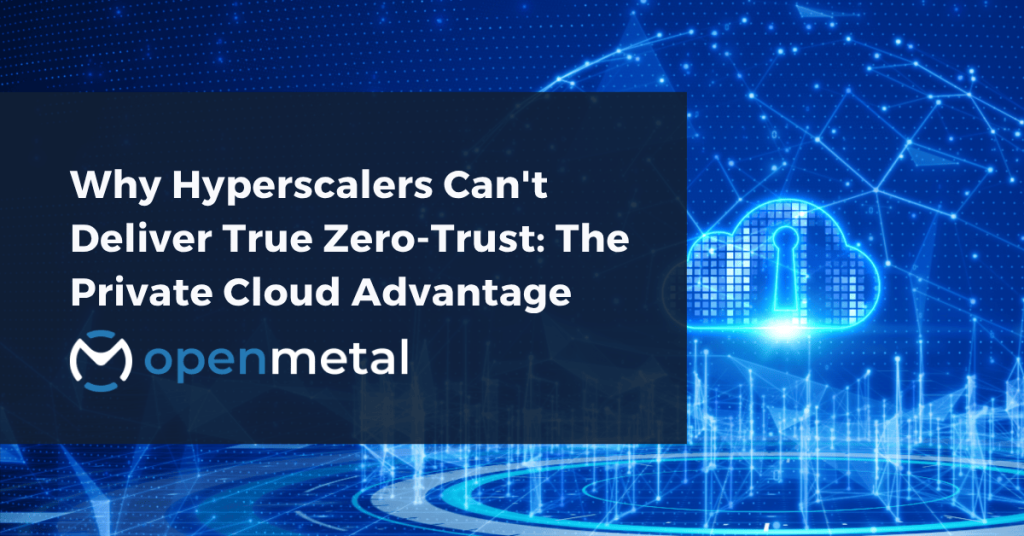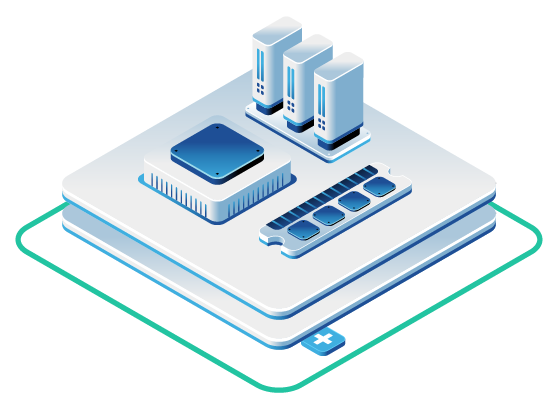
Ready to explore a private cloud that supports your zero-trust networking goals?
The OpenMetal team is standing by to assist you with scoping out a fixed-cost model based infrastructure plan to fit your team’s requirements, budgets, and timelines.
Security teams have spent decades building network perimeters—VLAN segmentation here, firewall rules there—only to discover that the perimeter itself has become the problem. Today’s distributed workloads, cloud-native applications, and identity-driven access patterns demand something fundamentally different: a security model that doesn’t implicitly trust anything based on network location.
Enter zero-trust networking. But implementing zero trust inside private clouds requires moving beyond marketing buzzwords and vendor promises. It means rethinking how you enforce policies at the microsegment level, route traffic based on verified identities, and maintain visibility across every connection—capabilities that hyperscaler environments often obscure or restrict.
OpenMetal’s hosted private cloud architecture makes zero trust operationally achievable by giving you transparent control over your network infrastructure. Let’s explore what that actually means in practice.
What Zero Trust Really Means (Beyond the Hype)
Zero trust represents a collection of concepts designed to minimize uncertainty when enforcing access decisions in systems and services, viewing the network as inherently compromised. A zero trust architecture encompasses component relationships, workflow planning, and access policies that assume no implicit trust is granted to assets or user accounts based solely on their physical or network location.
Three core principles define zero trust:
Never trust, always verify. Every access request must be authenticated and authorized before being granted, regardless of where it originates. The request from a device on your internal network deserves the same scrutiny as one coming from the internet.
Enforce least privilege. Grant only the minimum access needed to complete a specific task, for exactly as long as necessary. Access to resources is determined by dynamic policy that considers client identity, application state, requesting asset characteristics, and behavioral and environmental attributes.
Assume breach. Design your architecture knowing that attackers may already be inside. Focus on limiting lateral movement and containing damage rather than assuming your perimeter keeps threats out.
Why VLANs and Firewalls Fall Short
Traditional network security relies on perimeter defenses—the idea that once you’re “inside” the network, you’re trusted. VLANs segment networks into broadcast domains, and firewalls control traffic between zones. These tools served their purpose when applications lived in data centers and users sat at office desks.
But today’s infrastructure tells a different story:
Workloads are distributed. Your applications run across on-premises infrastructure, multiple cloud providers, and edge locations. The “network perimeter” has dissolved into dozens of interconnection points.
Users are everywhere. Remote work, contractor access, and partner collaboration mean authorized users connect from anywhere. Backhauling all traffic through your data center creates bottlenecks and degrades performance.
Attackers move laterally. Once attackers breach the perimeter, further lateral movement becomes unhindered in traditional architectures. A compromised laptop on the office network can potentially access any resource within the same VLAN.
VLANs operate at layer 2, treating all devices within a segment as equally trustworthy. Firewalls work at layers 3 and 4, controlling traffic based on IP addresses and ports—information that tells you nothing about whether a specific user should access a particular resource at this moment.
Zero Trust in the Cloud Era: The Building Blocks
Implementing zero trust in private clouds requires four foundational capabilities working together:
Identity-Based Networking
Move beyond IP addresses as the basis for access decisions. In zero trust architectures, policy engines evaluate identity (both user accounts and service identities), asset security posture, and contextual attributes before granting access to resources.
Modern identity-based networking maps policies directly to authenticated identities. When a developer’s laptop requests access to a production database, the system verifies the developer’s identity, checks their assigned permissions, evaluates the device’s security posture, and considers contextual factors like time of day and geolocation—all before making an access decision.
Microsegmentation and Workload Isolation
Traditional segmentation divides networks into large zones. Microsegmentation takes this to the workload level, creating granular security boundaries around individual applications or even specific functions within an application.
Zero trust architectures using microsegmentation place infrastructure devices such as intelligent switches, next-generation firewalls, or special-purpose gateway devices to act as policy enforcement points protecting each resource or small group of related resources.
With proper microsegmentation, each workload operates in its own isolated segment with explicitly defined communication paths. A compromised web server can’t automatically pivot to attack your database servers—every connection attempt requires fresh authorization.
Network overlays like VXLAN enable this level of granularity without requiring physical network redesigns. You can map virtual network segments to match your security policies, isolating workloads based on sensitivity, compliance requirements, or blast radius considerations.
Service Mesh Integration
Service meshes bring zero trust principles to application-layer communication. Service meshes provide strong identity, transparent TLS encryption, and authentication, authorization, and audit tools to protect services and data, operating as policy enforcement points between clients and servers.
A service mesh like Istio automatically handles mutual TLS between services, encrypts all traffic, and verifies identities on every request. When workloads communicate using mutual TLS authentication, client and server-side proxies establish secure connections, verify service accounts, and authorize requests before forwarding traffic to backend services.
This creates zero-trust enforcement at the service level—every microservice interaction becomes an opportunity to validate identity, check authorization policies, and log the transaction for audit purposes.
Policy Enforcement Points at Multiple Layers
Zero trust isn’t a single checkpoint; it’s continuous verification throughout the network stack. Policy enforcement points enable, monitor, and terminate connections between subjects and resources, communicating with policy administrators to forward requests and receive policy updates.
You need enforcement at:
- Network layer: Controlling which workloads can communicate
- Transport layer: Encrypting connections and verifying endpoints
- Application layer: Authorizing specific API calls or data access
- Data layer: Applying fine-grained permissions to individual records
The Hyperscaler Zero-Trust Problem
Public cloud providers market zero-trust capabilities, but their implementations face inherent limitations that stem from their shared infrastructure model.
Black-Box Network Fabrics
Hyperscalers abstract their physical network infrastructure behind APIs and management consoles. You see virtual networks and security groups, but you lack visibility into the actual packet flows, routing decisions, and traffic patterns beneath the abstraction.
Want to inspect east-west traffic between your own workloads? You’ll need to route it through provider-specific services, each with its own cost model and performance characteristics. Need to integrate with existing security tools? You’re limited to whatever APIs the provider exposes.
Provider-Defined Security Models
Hyperscaler security follows the provider’s interpretation of zero trust. You work within their pre-built constructs: their identity systems, their network segmentation models, their logging formats.
This creates gaps when your security requirements don’t align with their product roadmap. Implementing custom policy enforcement or integrating with specialized security tools often requires workarounds, third-party services, or accepting limitations.
Cost and Performance Penalties
Zero trust requires inspecting every connection, logging all requests, and maintaining continuous visibility. In hyperscaler environments, these activities directly impact your bill.
Egress charges apply when traffic crosses availability zones or regions—even between your own workloads. Running security inspection at scale means provisioning more instances, triggering higher compute costs. Storing audit logs long-term accumulates storage and retrieval fees.
The result: implementing thorough zero-trust policies becomes a cost-optimization exercise rather than a security decision. You make compromises based on budget rather than risk.
How OpenMetal Enables Zero Trust
OpenMetal’s hosted private cloud architecture solves the visibility and control problems that limit zero trust in hyperscaler environments.
Transparent Architecture on Dedicated Hardware
Every OpenMetal private cloud runs on dedicated, bare-metal infrastructure. You’re not sharing physical servers, network ports, or storage controllers with other tenants. This dedicated model provides several zero-trust advantages:
Complete network visibility. You see actual packet flows, not virtualized abstractions. Deploy packet capture tools, network analyzers, or security monitoring appliances without restriction. The underlying network topology is knowable and observable.
Direct hardware access. Configure network interfaces, VLANs, and routing precisely how your security policies require. No restrictions on MTU sizes, VLAN tags, or network protocols.
Predictable performance. Security inspection doesn’t compete with other tenants’ workloads. Your intrusion detection systems, DPI appliances, and logging infrastructure get dedicated resources.
VXLAN Overlays for Microsegmentation
OpenMetal provides full control over virtual network overlays, enabling microsegmentation that matches your security requirements exactly.
Configure VXLAN tunnels to create isolated network segments for different application tiers, compliance zones, or trust levels. Each segment operates independently, with explicitly defined communication paths enforced by your policy engine.
Unlike hyperscaler VPCs with provider-imposed limitations, your VXLAN configuration is entirely under your control. Define as many segments as you need, structure them hierarchically or flat, and reconfigure them as your architecture evolves—without asking permission or filing support tickets.
Full Administrative Control for Custom Enforcement
OpenMetal gives you root access to your infrastructure. Deploy any security tools, implement any policy enforcement model, or integrate with any identity provider.
Want to implement a custom policy decision point using your own algorithms? Deploy it. Need to integrate with specialized compliance tools? Install them. Prefer a specific service mesh implementation? Configure it exactly how you want.
This administrative freedom extends to the entire stack—from the physical network layer through the virtualization platform to the orchestration and application layers. Your zero-trust architecture reflects your requirements, not your cloud provider’s product strategy.
Free Internal Traffic: Security Without Cost Penalties
Internal traffic between workloads in your OpenMetal private cloud incurs no bandwidth charges. This economic model transforms how you approach zero-trust security.
Inspect everything. Route all east-west traffic through security inspection points without worrying about egress fees. Every connection can be logged, analyzed, and audited.
Implement defense in depth. Deploy multiple layers of security scanning—network IDS, application firewall, DLP—without each layer adding to your cloud bill.
Store comprehensive logs. Maintain detailed audit trails of all network activity without storage costs escalating based on traffic volume. When security measures don’t create surprise charges, you make decisions based on risk management rather than cost avoidance.
Integration with Broader Security Frameworks
Zero-trust networking doesn’t exist in isolation. It needs to integrate with your broader security architecture, including SASE and SD-WAN deployments.
SASE Integration
Secure Access Service Edge delivers converged network and security capabilities including SD-WAN, secure web gateway, cloud access security broker, next-generation firewall, and zero trust network access. SASE enables zero trust access based on device or entity identity combined with real-time context and security and compliance policies.
OpenMetal private clouds integrate cleanly with SASE architectures. Your private cloud becomes a trusted location in your SASE fabric, with policy enforcement points that communicate with your SASE controller for unified policy management.
Deploy SASE edge nodes within your OpenMetal infrastructure to inspect traffic before it reaches your applications. Or integrate OpenMetal’s network security capabilities with cloud-based SASE services for hybrid enforcement—local inspection for east-west traffic, cloud-based protection for internet-bound flows.
Software-Defined WAN Connectivity
SD-WAN provides intelligent routing and encryption for site-to-site connectivity. When you combine SD-WAN with OpenMetal’s private cloud infrastructure, you create a unified network fabric that extends zero-trust policies across all locations.
Configure SD-WAN tunnels between your OpenMetal cloud and branch offices, remote data centers, or other private clouds. Apply consistent security policies regardless of physical location. Route traffic based on application requirements, path quality, and security posture.
The transparency of OpenMetal’s network architecture means your SD-WAN solution sees actual network conditions and can make informed routing decisions. No hidden abstraction layers interfering with path selection or quality measurement.
Compliance-Friendly Auditability
Regulatory frameworks increasingly require detailed audit trails of data access and network activity. Zero-trust architectures generate these logs naturally—every access decision creates an auditable event.
OpenMetal’s infrastructure provides compliance advantages:
Complete log retention. Store logs as long as regulations require without worrying about cloud storage costs escalating.
Tamper-evident logging. Deploy logging infrastructure with your preferred security controls—write-once storage, cryptographic signing, or blockchain-based verification.
Regulatory data locality. Keep sensitive logs within specific geographic boundaries or compliance zones.
When auditors ask “who accessed what data, when, and from where,” you have comprehensive answers because your zero-trust architecture captured that information at every decision point.
Security-First Private Cloud: The OpenMetal Difference
Most organizations approach zero trust as a set of capabilities to bolt onto existing infrastructure. OpenMetal flips this model: the private cloud itself becomes a security-first platform where zero trust is native, not bolted on.
This architectural difference matters in practice. When your infrastructure provides transparent networking, dedicated resources, and full administrative control, implementing zero-trust policies becomes an engineering task rather than a negotiation with your cloud provider’s limitations.
Your policy engines have access to actual network telemetry. Your enforcement points can inspect every packet without performance penalties or cost concerns. Your security team can deploy the exact tools and configurations that match your risk profile.
Traditional private clouds often replicate hyperscaler abstractions on-premises, bringing the same visibility limitations and vendor lock-in. OpenMetal provides the transparency and control that hyperscalers can’t deliver—while maintaining the operational simplicity and scalability you expect from modern cloud infrastructure.
The result: zero trust moves from aspirational security framework to daily operational reality. You gain packet-level visibility, identity-based access control, microsegmented workload isolation, and comprehensive audit trails—all running on infrastructure you control completely.
The Path Forward
Zero trust succeeds when infrastructure makes it achievable rather than fighting against it. VLANs and firewalls served their purpose in perimeter-based security, but distributed workloads and identity-driven access demand something fundamentally different.
OpenMetal’s hosted private cloud provides the transparency, control, and economic model that enable true zero-trust networking. You get dedicated hardware with complete visibility, network overlays configured exactly how your policies require, and administrative freedom to implement security your way—without surprise charges penalizing thorough inspection and logging.
The question isn’t whether zero trust is the right security model for modern infrastructure. The question is whether your infrastructure gives you the visibility and control to implement it effectively.
With OpenMetal, the answer is yes.
Ready to implement zero-trust networking without the visibility gaps and cost penalties of hyperscaler environments? OpenMetal’s hosted private clouds give you the transparent infrastructure, dedicated resources, and complete administrative control your security architecture demands.
Read More Blog Posts
Works Cited
- Rose, Scott, et al. “Zero Trust Architecture.” NIST Special Publication 800-207, National Institute of Standards and Technology, Aug. 2020, nvlpubs.nist.gov/nistpubs/SpecialPublications/NIST.SP.800-207.pdf.
- “Secure Access Service Edge (SASE).” Gartner Information Technology Glossary, Gartner, www.gartner.com/en/information-technology/glossary/secure-access-service-edge-sase. Accessed 5 Oct. 2025.
- “Security.” Istio, istio.io/latest/docs/concepts/security/. Accessed 5 Oct. 2025.


































